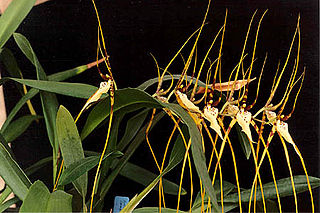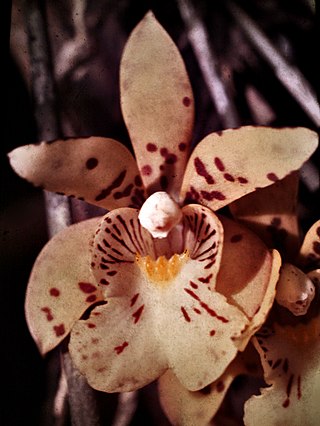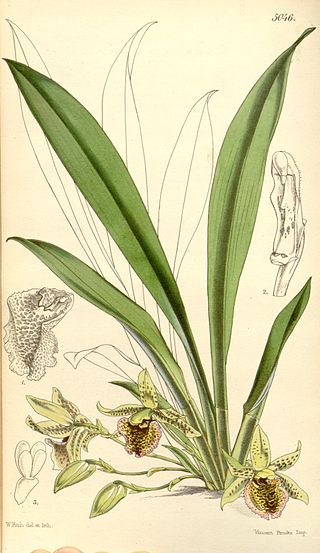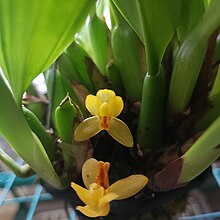
Gongora, abbreviated Gga in horticultural trade, is a member of the orchid family (Orchidaceae). It consists of 65 species known from Central America, Trinidad, and tropical South America, with most species found in Colombia. They grow across a wide geographical range, from wet forests at sea level, to mountainous regions in the Andes, as high as 1,800 m.

Catasetum, abbreviated as Ctsm. in horticultural trade, is a genus of showy epiphytic Orchids, family Orchidaceae, subfamily Epidendroideae, tribe Cymbidieae, subtribe Catasetinae, with 166 species, many of which are highly prized in horticulture.

Oncidium, abbreviated as Onc. in the horticultural trade, is a genus that contains about 330 species of orchids from the subtribe Oncidiinae of the orchid family (Orchidaceae). As presently conceived, it is distributed across much of South America, Central America, Mexico and the West Indies, with one species (O. ensatum) extending into Florida. Common names for plants in this genus include dancing-lady orchid and golden shower orchid.

Cattleya is a genus of orchids from Costa Rica south to Argentina. The genus is abbreviated C in trade journals.

Brassia is a genus of orchids classified in the subtribe Oncidiinae. It is native to Mexico, Central America, the West Indies, and northern South America, with one species extending into Florida.

Aganisia is a small South American genus in the orchid family (Orchidaceae), subfamily Epidendroideae.

Maxillaria, abbreviated as Max in the horticultural trade, is a large genus of orchids. This is a diverse genus, with very different morphological forms. Their characteristics can vary widely. They are commonly called spider orchids, flame orchids or tiger orchids. Their scientific name is derived from the Latin word maxilla, meaning jawbone, reflecting on the column and the base of the lip of some species, that may evoke a protruding jaw.

Stenia is a genus in the orchid family (Orchidaceae). It was established by John Lindley in 1837. These epiphytic plants occur in warm, humid habitats of Trinidad and the Amazonian slope of the northern Andean region in South America.

Bifrenaria, abbreviated Bif. in horticultural trade, is a genus of plants in family Orchidaceae. It contains 20 species found in Panama, Trinidad and South America. There are no known uses for them, but their abundant, and at first glance artificial, flowers, make them favorites of orchid growers.

Scuticaria is a genus of orchids comprising 9 species native to Belize, Brazil, Ecuador, French Guiana, Guyana, Peru, Suriname and Venezuela. Members of this genus have showy flowers and long cylindrical leaves. They are epiphytic, occasionally lithophytic or terrestrial, that grow pending and are cespitously, or reptant and ascending, which exist is three isolated areas of South America, in Ecuador, Amazon Forest and Serra do Mar and Serra da Mantiqueira mountains, in Brazil, both in shady and sunny places.
Trigonidium, abbreviated as Trgdm in horticultural trade, was a formerly accepted genus of orchids comprising roughly twenty species found from Mexico to Brazil. As of 2023, it was considered a synonym of Maxillaria.

Cattleya walkeriana, or Walker's cattleya, is a species of orchid. It differs from most species of Cattleya by having inflorescences which arise from the rhizome instead of from the apex of the pseudobulb. In its native habitat it grows as either an epiphyte or a lithophyte, sometimes in full sun. Pseudobulbs are relatively short, bulbous or fusiform, with one or two ovate leaves at the apex. Inflorescence is one- or few-flowered, about 8" (20 cm) tall. Flowers are 4-5" (9-12 cm) across.

Maxillaria rufescens, the light fox-red maxillaria, is a species of orchid native to Trinidad and the Amazon Basin in Colombia, Ecuador, Peru, Bolivia, Venezuela, The Guianas and Brazil. The plant grows at elevations of 200 to 2000 meters, and grows up to 11⁄4 inches.

Peristeria elata is a species of orchid occurring from Central America to Panamá, Venezuela, and Ecuador. It is the type species of its genus. It is commonly referred to as the Holy Ghost orchid, dove orchid, or flower of the Holy Spirit in English, and, as the flor del Espiritu Santo in Spanish.

Phymatochilum brasiliense is an orchid species, inhabitant of Serra do Mar mountains in Brazilian southeast and northeast, which vegetatively resembles Oncidium species, however, is more closely related to the genus Miltonia. It is the only species of the genus Phymatochilum.

Kefersteinia is a genus of flowering plants from the orchid family, Orchidaceae. It has about 40-50 species, widespread across much of Latin America. The genus was named for Keferstein of Kröllwitz, an orchidologist.
Maxillaria donaldeedodii, synonym Ornithidium donaldeedodii, is a species of orchid native to Haiti. It was "discovered" in April 2010 when DNA analysis showed that a wrongly labeled orchid at the University of California Botanical Garden in Berkeley, California, was actually a distinct new species. The "new" orchid, which had been mislabeled as Maxillaria croceorubens since the 1990s, was named after orchidologist Donald D. Dod (1912–2008), who collected the specimen in the 1980s in Haiti. The new orchid was officially described in Lankesteriana, an international journal on orchidology, by authors James Ackerman of the University of Puerto Rico and W. Mark Whitten of the Florida Museum of Natural History, as Ornithidium donaldeedodii. It was transferred to Maxillaria in 2011.

Maxillaria schunkeana is a species of orchid. The colors of its flower are very close to black, but it is actually a very dark purple-red, giving the impression of a black flower.
Leslie Andrew Garay, born Garay László András, was an American botanist. He was the curator of the Oakes Ames Orchid Herbarium at Harvard University, where he succeeded Charles Schweinfurth in 1958. In 1957 he was awarded a Guggenheim Fellowship.

Maxillaria obtusa, synonym Trigonidium obtusum, is an orchid native to tropical South America.


















